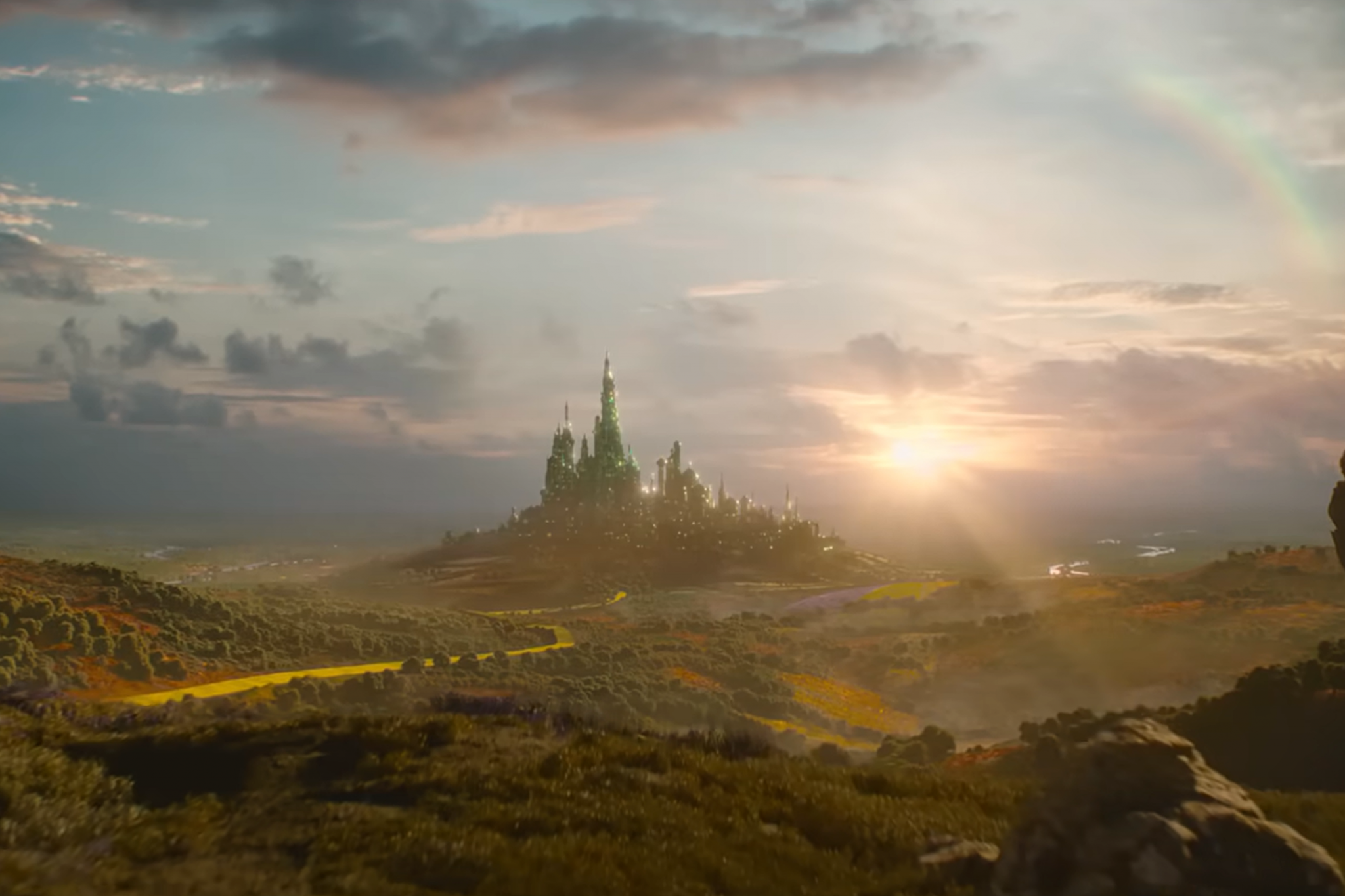The Wizard of Oz might be better known for its visuals than its plot.
Dorothy’s slippers flash with duplicitous crimson, a buttery yellow brick road cuts through lush flora and the shimmering green shades of Emerald City are landmark images in cinema. Thinking of more than three songs from the movie could be tough for the average person, but forgetting its dreamy, otherworldly images is impossible.
Muted hues became a concern for many fans of Wicked, but director Jon M. Chu, known for In the Heights and Crazy Rich Asians, quiets any fears over the film’s coloring — Wicked is eye candy through and through. It omits technicolor decor synonymous with the original 1939 film, but the end result is a sleek, 21st century color finish that is less striking, but far cleaner.
But pay enough attention and you can spot a fragile plot behind the glitzy curtain.
Wicked for months tried to sell an elaborate fantasy dystopia, but struggles to not drag on by foregoing act two. Its choices to embellish upon glitz sacrifices a core part of its message.
The film succeeds amidst its contemporaries who’ve tried and failed to blur the lines between realism and musical theater. Wicked knows exactly what kind of movie it is, but picks pageantry over substance.
From the gilded marble and crystal gloss of Shiz University, to the sumptuous, dark emerald that built its iconic capital — coming into full bloom with “One Short Day” — every moment capitalizes on a vivid color palette.
[Dance, theater photography showcased at Michelle Smith Performing Arts Library exhibit]
The kaleidoscope flower fields of Munchkinland shift to sparkling rivers with rainbow fish as Glinda arrives at Shiz, illuminated to an almost excessive degree. Where modern films are rightfully lambasted for their lack of poor lighting, Wicked basks in the sunlight.
Spectacle is everything and Wicked delivers in droves to amp up the glamor of the stage play. Chu’s eye for movement keeps grand numbers from growing clunky. Songs flow seamlessly through intricate choreography, enhanced by everyday sounds woven into the score’s instrumental. In “One Short Day,” the mechanics of a salon complement the percussion.
The surreal “Dancing Through Life” sequence combines rotating cinematography twirls with the ensemble as it floats through the moving library, with Shiz’s students’ tap dancing to the song’s rhythm.
Jonathan Bailey delivers a career standout performance in the number as Fiyero, flirting with the camera as much as his classmates.
It’s easy to also fall in love with Ariana Grande’s Glinda as she nails her comedic high notes, chewing the scenery with every exaggerated scurry and doe-eyed expression. Vocally, she sounds the clearest she has since 2013, soaring in “No One Mourns The Wicked.” Welcome back, Yours Truly era!
Choosing to enhance the comedy in scenes where Grande falls a bit flat with the drama almost lets her off the hook. Still, her performance pales in comparison to Cynthia Erivo’s Elphaba.
Erivo tenderly carries the character from introverted, misunderstood outcast — slightly drier than in other stage adaptations — to fiery rebel. She takes moments to let emotional scenes breathe and reminds the film of its political purpose.
[Grammy nominations, charts signal growing acceptance of experimental music]
Authoritarianism and propaganda criticism come in increments and get lost in the dizzying fun of the musical numbers. If you’re not intently picking out subtle doublespeak, sudden betrayals and shocking arrests are haphazardly crammed in.
The film shines best within its high octane numbers, stunning vocal performances and when the message is simple — choose kindness — it’s like the world’s most exquisite Disney Channel original movie.
Yet, Wicked so badly wants to just softly critique discrimination. Even when toning down on its original source material, it’s still far more 1984 than it is High School Musical, and some people coming in for act two are in for a nasty surprise.
We spend more time watching Glinda flip her hair than exploring what makes these third-act antagonists suddenly evil dictators. Even knowing the contents of the stage play, the establishing sequence feels rocky.
It all makes more sense with the context of act two. In a regular production, the intermission between gives the impression of time passing and loose threads or hints at themes are amped up in the second act. Since this is just the one film though, it fails, outside of Elphaba’s gravitas, to embrace serious themes.
Annoying problems in the stage production became glaring issues when put to screen. And the film, so high on its own musical product, fails to address them. Instead, it attempts to sell me more shining, shimmering, splendid.
It wants to be a reinvisioned Hogwarts fantasy. To center a love triangle intertwined with the story of two diametrically opposed women learning to be friends and to have its political commentary cake.
Adding more cinematic flare and excess glitz to such a demanding story is a lot, and Wicked, in all its flashy glory, doesn’t quite rise to the challenge. It sacrifices the opportunity to expand on a bare-bones propaganda critique to drag out already legendary numbers.
Granted, these two problems meet in glorious, spectacular fashion in “Defying Gravity” — where it really counts — and I can’t be too upset about it.



